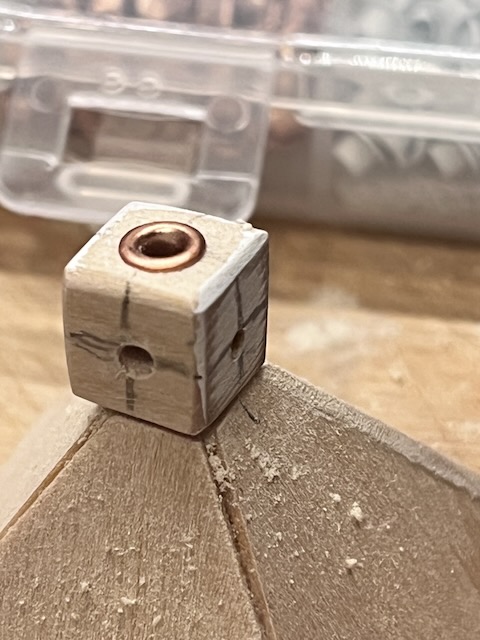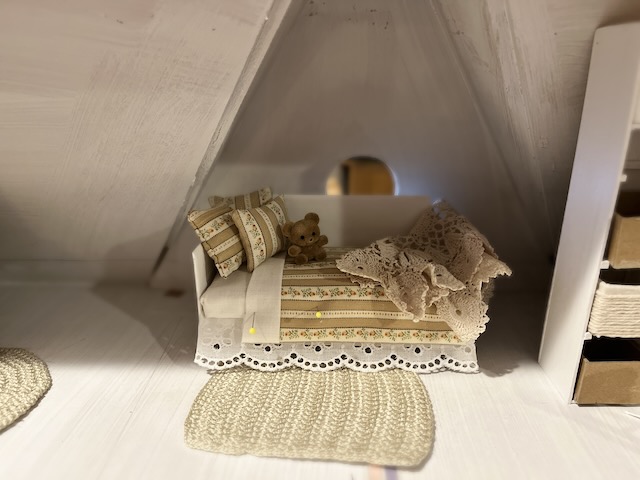The interior of the Manchester is pretty much finished. I've filled cracks and crevices with painter's white caulking, cut most of the trim to finish hiding rough edges, yet to be glued place, and done most of the touch-up painting. Major tasks left to do: glue the balcony back into place; attach the exterior trim, and the roof. I've considered Greenleaf's Speed Shingles that I used on the Bellingham; the faux asphalt strip shingles that could be costly, single shingles in my lumber stash, or a faux metal roof that would require only paint and strips of wood, glued in place.
But I can't make up my mind, so the exterior sits in limbo.
Just when I decided that I would not build another large house, I found a shell of the older Real Good Toys Newport on Facebook Market Place located near daughter Heather in Denver for $100. So tempted. It was missing the tower that sits on the mansard the roof, so I emailed RGT to see if they could provide replacement pieces--and they can, along with all the trim, windows, doors, interior walls, etc. I calculated the cost. Then went to eBay to see what I could see.
Another older Newport kit (now redesigned and renamed the New Haven). The eBay house is $175 with $110 shipping. A bit of calculation reveals that it would be a tad more expensive to get this kit with all the pieces included. I made an offer. It was rejected. So I decided that I just don't need another large house. Do I?
As I mull over the Newport, a Victorian Empire style that would be so much fun to make, I began working on the Manchester attic by making a day bed. Inspired by Carolyn's tutorial on how she makes her little daybeds at Cinderella Moments, I made my first daybed for the Bellingham and loved how easy it was to make and how great it turned out. You can see it here: DayBed, along with the full tutorial.
The bed is cut from 1/16" basswood, an easy hand-cut project; however, this time I used the Cricut Maker.

With new projects, I always cut a prototype out of thin cardboard--like a cereal box or even computer paper. My cardboard cutout is a GO.
First, writing a Cricut tutorial is tricky because, especially if you are brand new to your machine and want to dive in to make mini furniture making, you have learn how to use certain tools, so I suggest that you search for Youtube Tutorials to learn how to use the tools listed at the top of Design Space work space, along both sides, and the ones in the bottom right hand corner.
PLEASE before you attempt this bed and if you are new to your machine, learn how to cut basswood by taking a Youtube tutorial. There are many good ones. In addition, you can use craft board or chipboard instead of wood.
Tools to cut wood: Purple Mat, knife blade, painter's tape
This tutorial will demonstrate how to use the Shapes collection on the left and the Slice tool to create custom shapes, and the Attach tool. For this day bed I used a square sized to 5"x7"; used an oval to create the notched corners. Once I had one corner sliced, I used the Flip tool to flip the newly created triangle to move to the opposite side to make an exactly matched notch. You have to play around and use trial error to get the slices perfect. Use Command Z to quickly undo mistakes.
Next I created the sides: 2"x7, the bed of the bed slightly narrower, and the front brace.
This bed will have a tufted headboard, so I created my template for the tufting, which will be either print and cut or I can use a pen to mark the tufts. Carolyn's tutorial shows how to make a tufted headboard.
With the pieces created, I am ready to cut my wood. I can group my pieces in Design Space after creating them, but when I click Make and see the Make screen I see that Cricut has rearranged the pieces on my wood, waisting precious wood and disregarding the grain of the wood, so there is an easy solution.
For this project I used Circut's basswood--worth the price. It is 6"x12". I create a template of the wood then position my pieces on the template as the wood will be placed on the mat--the grain horizontal or parallel to the left side of the mat. With the pieces in position, I carefully side (drag) the wood template to the side and the pieces stay in place. Next I select all the pieces, not disturbing or moving them and Attach them, holding them in place. Remember command Z to immediately undo a mistake or incorrect move.
Now you can see that all of the pieces are in place and ready to cut. 1/16" basswood takes about 9 of 14 programmed passes, but I am thinking that Cricut has reprogramed the machine to stop cutting at 7 or 8 and I have discovered that the across grain cuts don't go all the way through, so I have to use my X-acto blade to finish the cut.
The cut results:
I used Gorilla Wood glue to adhere the pieces.
With a large fabric stash, including fabric pieces and scraps for mini-making, I found bed sheets that I had hemmed at one time. Not in the mood to do any sewing this time around, I used the sheets for this bed.
There are a number of materials that can be used for a mattress. I keep mine simple and use what I have on hand. I cut the mattress from 1/2" foam core board, slightly smaller 1/4" or so all the way around to allow room for bedding. Here, I am using wool batting left over from stuffing cloth dolls.
While my sheets have finished stitched edges, they don't have to be finished; in fact, the sewed edges create more bulk, so it's better not have finished edges.
Simple wrap bedsheet fabric around the mattress and glue in place.
I've not decided on the color pallet for the attic, but since I had scraps of the stripe and just wrapped it around and really like it. I had sewed the striped pillow and the other one came from the mini stash--for the moment.
While the bed isn't finished, it does seem to be turning out nicely. A comfortable place for some day sleepin'.
To finish dressing the bed, I added a dust skirt it a piece of eyelet edging from the lace stash. I taped most the fabric in place, and once I am satisfied with the how the bedding looks, I'll glue it all in place.
I made pillows--very simple: cut a rectangle twice the size of the finished pillow, fold it in half. I pressed the top edge to the inside to create an even hem once the stuffing is added.
Next I folded the fabric in half then I hand sewed around two edges. After turning the pillow right side out, I added a bit of stuffing and carefully glued the hem edge closed.
And there you have it: a cozy spot with a comfy bed to do some day sleepin'.
I'm so glad you dropped by. I'd love know what you are up.
Have a great week.
Ann


















































